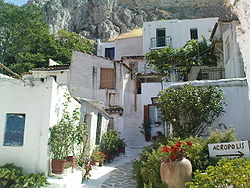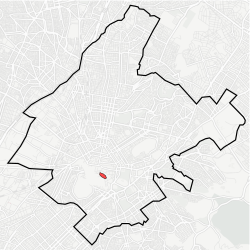Anafiotika
In today's world, Anafiotika is a topic that has generated a lot of interest and debate. From its origins to its relevance today, Anafiotika has been the subject of study and research by experts in various disciplines. Its impact on society, culture and the economy has been significant, and its influence has spread globally. In this article, we will explore the different facets of Anafiotika, from its evolution over time to its implications in the contemporary world. We will analyze its importance and reflect on its relevance in the current context, with the aim of providing a comprehensive and updated vision on this topic.
Anafiotika
Αναφιώτικα | |
|---|---|
Neighborhood | |
 Anafiotika | |
 Location within municipality of Athens | |
| Coordinates: 37°58′20″N 23°43′40″E / 37.97222°N 23.72778°E | |
| Country | Greece |
| Region | Attica |
| City | Athens |
| Postal code | 105 58 |
| Area code | 210 |
| Website | www.cityofathens.gr |
Anafiotika (Greek: Αναφιώτικα pronounced [a.naˈfço.ti.ka]) is a scenic tiny neighborhood of the center of Athens, part of the old historical neighborhood called Plaka. It lies on the northeast side of the Acropolis hill.
History
The first houses were built in the era of Otto of Greece, when workers from the island of Anafi came to Athens in order to work as construction workers in the refurbishment of King Othon's Palace.[1] The first two inhabitants were listed as G. Damigos, carpenter, and M. Sigalas, construction worker. Soon, workers from other Cycladic islands also started to arrive there, to work as carpenters or even stone and marble workers, in a further building reconstruction period in Athens, but also in the following era after the end of the reign of King Otto.

In 1922, Greek refugees from Asia Minor also established here, altering the population that was up to that time only from the Cycladic islands. In 1950, part of this neighborhood was destroyed for archeological research and in 1970 the state started to buy the houses. In the modern era, there are only 45 houses remaining,[2] while the little streets from Stratonos to the Acropolis rock are still unnamed and the houses are referred to as "Anafiotika 1", "Anafiotika 2", etc.[3]
The neighborhood was built according to typical Cycladic architecture, and even nowadays gives to visitors the feel of Greek islands in the heart of the city, with white walls and small spaces, usually with the presence of bougainvillea flowers. Houses are small and mostly cubic, small streets that often end up to ladders or even deadends at terraces, where one can sit and enjoy the night view of the city. "In this oasis of tranquility, nestled beneath the walls of the Acropolis, the intensity of Athens seems miles away"...[4]
References
- ^ Ragos, Giannis (2004). Atenas - Ática (Nº 19). Atenas: Organismo Griego de Turismo. 960-534-037-2.
- ^ Roxani Caftanzoglou, "The sacred rock and the profane settlement: place, memory and identity under the Acropolis", Oral History 2000, 28: 53-85. See also Roxani Caftanzoglou, 2001 The Shadow of the sacred rock: contrasting discourses of place under the Acropolis, Berg
- ^ Arxeioeie.gr Archived 20 February 2011 at the Wayback Machine
- ^ "Athens Greece The Tranquil Anafiotika Neighborhood : Rick Steves Europe Video Pg#15". 8 July 2011. Archived from the original on 8 July 2011. Retrieved 12 May 2022.